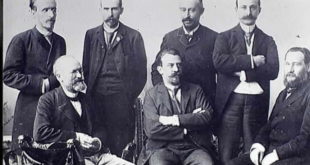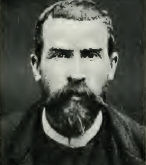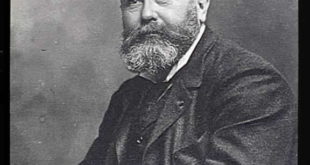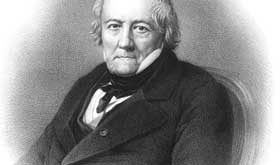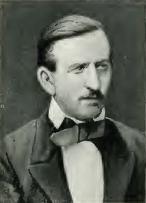
During the course of this doctorate program, Raulin made the acquaintance of the renown Louis Pasteur, who had just been granted a small laboratory by the school administrators. It had been Pasteur’s goal to establish practical laboratories at all of the institutions of higher learning, particularly at the École Normale but many years passed before he won his case. The room was formerly occupied by the school architect and was nothing more than a pavilion; but to Pasteur, it was to be an institution, thenceforth simply referred to as Rue d’Ulm. Pasteur argued so convincingly that the architect indulged him with a small addition to the building, even decorating it with a bust of Lavoisier. Pasteur argued further, that the school was in need of a new program for graduates, in order that they may peruse independent research, and delay their mandatory teaching appointments. This is precisely what Pasteur secured for himself, years earlier, as a special privilege when he completed his aggregation. It was a curatorship, or what was officially named préparateur agrégé. Fortunately for Raulin, the new program was implemented during his term. Being clear minded, Pasteur chose Raulin to be his first assistant to the new laboratory, in 1859. Raulin benefited greatly from those few years with Pasteur. The work he began there would eventually blossom into a profound scientific breakthrough which would greatly benefit Pasteur in return.
Initiated by his mentor into the new cult of microbes, Raulin took special interest in a microscopic fungus called Aspergillus niger. Employing Pasteur’s artificial mediums, or known chemical mediums, he discovered the most favorable conditions for this fungus to multiply. Sadly, Raulin was unable to suspend his obligation any longer. The administrators deployed him first to Brest at the end of 1861 and later to Caen.
While separated, Pasteur uplifted his pupil with these words: “Keep up your courage, do not allow the idleness of provincial life to disturb you. Teach your pupils to the very best of your ability and give up your leisure to experiments. This was M. Biot’s advice to myself”
Raulin had still not produced a doctoral thesis. He was intensely trying to manifest the general conclusions from the work that began at the Rue d’Ulm. The research would detain him for the next 7 years; all the while, Pasteur was anxious to see the results. He pleaded with Raulin to share his steps with the community of scholars. He insisted that he come to Arbois to assist in the experiments on wine, and again year after year, he called out for help on the silk worm disease. During this perserverance, Pasteur changed his mood- he would playfully refer to Raulin as the “temporizer”, because of his tarrying. Although he never joined the group at Arbois, Raulin made time to study the pébrine malady from his outpost between 1866 and 1869, and contributed a helpful method of selection for silk worm seed.
In 1870 he was finally ready to publish his findings. Pasteur excitedly hurried to Caen to reunite with his beloved pupil. The results astounded him. Through meticulous strategies, Raulin was able to pinpoint the exact formula which produced the most rapid growth of mold, factoring in temperature and the type of receptacle used. Pasteur called this a “Raulin liquid.” For example, the Aspergillus niger mucor thrived most in 1500 gm of water, plus 70 gm of sugar, 4 gm each of tartaric acid, ammonium phosphate and ammonium nitrate and so on, down to the decimal amounts of other salts. Conversely, Raulin determined the subtle amounts of metallic salts which could arrest all growth. His report also evaluated how much oxygen was absorbed wort of beer, when shaken vigorously, how much more by yeast water. This furthered Pasteur’s understanding of the metabolism of yeast.
Pasteur gave his work the highest approbation and recommended it to his colleagues. The work, entitled, ‘Études chimique sur la végétation, et recherches sur le développement d’une Mucédinée, dans un milieu artificiel’ (Chemical study on vegetation, and research on the development of a fungus of the family Aspergillus niger under artificial conditions), was awarded the Experimental Physiology prize. It seems almost needless to say, that Raulin received his doctorate. Raulin was grateful to Pasteur who he declared had given him the method, suggestive ideas, and the encouragement to accomplish this work.
In the following years, Raulin, now disposed of his responsibilities, was free to reunite with his mentor. Pasteur was able to appoint Raulin once again to his laboratory at the École Normale, where the work on silk worms continued alongside the perpetual experiments on fermentation and oxidization. From 1873 to 1874 they studied fermentation of beer; their “field work” being conducted at the café Tassigny, in Reims. The “Pasteur process”, later pasteurization, was introduced to industry. Together the two built heating apparatuses which would allow industries to pasteurize on a grand scale. They shared a vision of the future: an industrialized France, benefiting from science.
In 1876, he took the chair of Chemistry at the Faculté de Lyon, and like his mentor, established a new institution, the Industrial School of Chemistry. He continued to labor for new advances in agriculture by overseeing an agronomic “station” along the Rhone, where new fertilizing methods were investigated. Over the years he was recognized for his achievements. He was made dean of the Faculté des sciences, in Lyon, where he remained until his death. In 1886 he was awarded the Legion of Honor, in 1888 he was inducted into the Pasteur Institute as a founding member. He remained life long friends with Pasteur, Duclaux and Gernez.
Among his successors were Marcel Mérieux, Victor Grignard, who received the Nobel Prize for Chemistry in 1912 and Marcel Pretre, founder of the Institut de Recherche sur la Catalyse.
 Pasteur Brewing Louis Pasteur – Science, Health, and Brewing
Pasteur Brewing Louis Pasteur – Science, Health, and Brewing 